

|
 |
Penthouse North AKA Blindsided (Blu-ray)
[Blu-ray]
Blu-ray B - United Kingdom - Image Entertainment Review written by and copyright: Paul Lewis (24th January 2014). |
|
The Film
 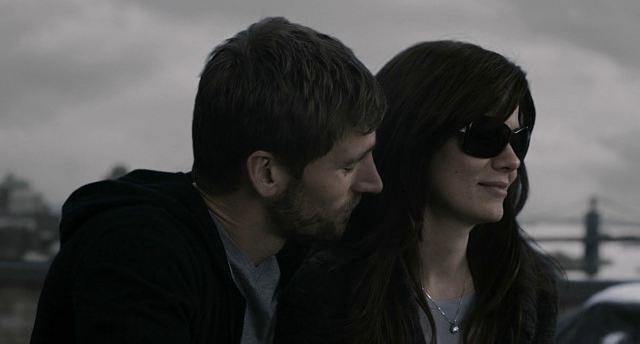 Penthouse North (Joseph Ruben, 2013) Penthouse North (Joseph Ruben, 2013)
The ‘yuppie-in-peril’ cycle was an interesting but short-lived fad within American cinema. Beginning roughly in the mid-1980s with films such as Martin Scorsese’s After Hours (1985) and Jonathan Demme’s Something Wild (1986), the cycle had some parallels with the neo-noir movement: for example, Carl Colpaert’s Delusion (1991) and Dominic Sena’s Kalifornia (1993) are all both yuppie-in-peril films and examples of neo-noir, featuring yuppie protagonists who find their lives intertwined with those of killers. During the late-1980s and early-1990s, the yuppie-in-peril cycle featured a number of films in which middle-class urbanites find their home lives disrupted by those defined as ‘other’ (usually working-class men). The films often climaxed with an extended ‘home invasion’ sequence. (John Hughes’ Home Alone, 1990, is a comic take on this fairly short-lived trend.) Unlawful Entry (Jonathan Kaplan, 1992) features middle-class couple Kurt Russell and Madeline Stowe terrorised in their home by Ray Liotta’s obsessed cop; Barbet Schroeder’s Single White Female (1992) features software designer Bridget Fonda renting a room to Jennifer Jason Leigh in her home, only to discover that her new tenant’s behaviour becomes increasingly disturbing; John Schlesinger’s Pacific Heights (1990) focuses on a middle-class couple (Matthew Modine and Melanie Griffith) who purchase an expensive house in Pacific Heights with the aim of renovating it, and rent out one of the apartments within the building to Michael Keaton, who gradually reveals himself to be a violent criminal and conman. 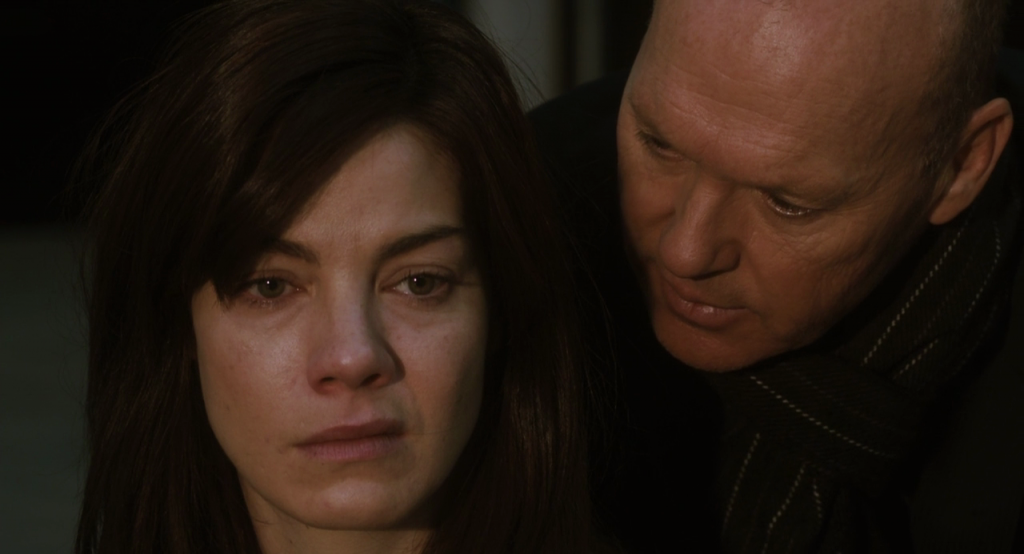 Penthouse North (recently shown on the US channel Lifetime under the alternate title Blindsided) features Keaton in a role similar to the one he took in Pacific Heights. The film is directed by Joseph Ruben, who directed one of the first wave of yuppie-in-peril films, Sleeping with the Enemy (1991), in which Julia Roberts struggles to escape from the grip of her controlling husband (Patrick Bergin). (One of Ruben’s most effective thrillers, the 1993 film The Good Son, featured Home Alone’s Macauley Culkin as a psychopathic child, a fact which led to the BBFC waiting two years until they finally granted the film an ‘18’ certificate.) Like some of the early-1990s yuppie-in-peril films cited above, Penthouse North features a home invasion plot in which a middle-class woman (former photojournalist Sara, played by Michelle Monaghan) finds her comfortable New York penthouse invaded by a pair of violent criminals Hollander (Michael Keaton) and Chad (Barry Sloane), who reveal that her boyfriend Ryan (Andrew W Walker) also has a criminal past. Penthouse North (recently shown on the US channel Lifetime under the alternate title Blindsided) features Keaton in a role similar to the one he took in Pacific Heights. The film is directed by Joseph Ruben, who directed one of the first wave of yuppie-in-peril films, Sleeping with the Enemy (1991), in which Julia Roberts struggles to escape from the grip of her controlling husband (Patrick Bergin). (One of Ruben’s most effective thrillers, the 1993 film The Good Son, featured Home Alone’s Macauley Culkin as a psychopathic child, a fact which led to the BBFC waiting two years until they finally granted the film an ‘18’ certificate.) Like some of the early-1990s yuppie-in-peril films cited above, Penthouse North features a home invasion plot in which a middle-class woman (former photojournalist Sara, played by Michelle Monaghan) finds her comfortable New York penthouse invaded by a pair of violent criminals Hollander (Michael Keaton) and Chad (Barry Sloane), who reveal that her boyfriend Ryan (Andrew W Walker) also has a criminal past.
In the opening sequence, Sara is shown attached to a group of soldiers in Parwan Province, Afghanistan. A firefight breaks out suddenly, and Sara takes shelter in what seems to be an empty slaughterhouse. However, inside she encounters a woman in a burqa who is carrying what seems to be a baby. The woman speaks to Sara, appearing to beg her to help her child. Sara photographs the woman and freezes, realising that the child is in fact a doll and that the woman is a jihadist. The explosive device that the woman is carrying detonates, and the opening credits roll. When they end, we find Sara living in a penthouse in New York City. It is New Year’s Eve, three years after the incident in Afghanistan. Sara was blinded in the blast, and she lives an isolated life with her boyfriend Ryan; Ryan is protective of her, but Sara struggles to retain her independence, insisting on paying a visit to the local shop by herself. On her way to the shop, Sara is knocked down by a cyclist. (‘Are you blind?’, he asks angrily. ‘Yes’, is Sara’s delayed response to his question.) She is helped to her feet by a young man, Chad. Returning to her penthouse apartment, Sara is unaware that Ryan is dead, lying on the floor of the kitchen in a pool of his own blood. Sara is also unaware that she is not alone: Chad is also in the apartment. He threatens Sara and holds her captive, but she manages to escape and, after a prolonged chase, flees onto the street. There she meets Hollander, who claims to be an Assistant District Attorney; he escorts Sara to what she believes to be safety, before revealing that he is in fact in league with Chad. Dragging Sara back to her apartment, Hollander reveals that Ryan stole a huge amount of money and diamonds from both he and Chad, and angry with Chad for killing Ryan before he was able to extract information as to where the money and diamonds are hidden, Hollander believes Sara is aware of where the items he and Chad seek are concealed. Hollander and Chad terrorise Sara in her penthouse apartment, hoping she will lead them to their money. 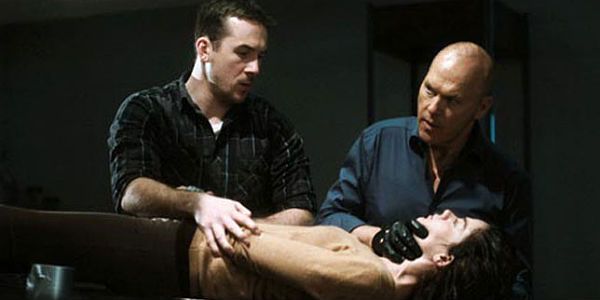 The film’s narrative is simple, reminiscent not only of the yuppie-in-peril cycle but also Terence Young’s Wait Until Dark (1967, based on Frederick Knott’s 1966 play), in which a blind Audrey Hepburn is terrorised by a group of criminals (Alan Arkin, Richard Crenna and Jack Weston) who believe that a doll stuffed with heroin is concealed in her apartment. Nevertheless, the film updates the premise of Wait Until Dark and seems to reach for a metaphor about the 21st Century ‘War on Terror’ and its impact – with Sarah’s nightmarish experiences in her plush penthouse being paralleled, via the use of repeated flashbacks, to the incident in Afghanistan that left her blind. The slaughterhouse in which Sara encounters the jihadist is, later in the film, referenced obliquely in the dialogue. Hollander offers to let Sara keep one of the diamonds if she tells him where the rest are hidden, noting ‘If I were you…’ ‘I’m nothing like you’, Sara protests, ‘You kill people’. ‘Yeah’, Hollander interrupts, ‘The world’s a slaughterhouse, full of pigs who are just too stupid to see when the axe comes down’. Waterboarding, an ancient torture and interrogation method made current by the CIA’s controversial use of it against suspected members of Al-Qaeda, is another all-too-familiar part of the iconography of the War on Terror which appears in the film: finding themselves against a brick wall in their questioning of Sara as to the whereabouts of the money and diamonds (Sara appears genuinely to have no knowledge of Ryan’s past), they submit her to waterboarding in an excruciating sequence that reinforces the sadistic villainy of both criminals. Additionally, the connection of the events in the penthouse with Sara’s experiences in Afghanistan is consolidated when the money Ryan has taken from Hollander and Chad is revealed to be hidden in a large canvas print of one of Sara’s photographs: an enigmatic HDR-type shot, taken from a canted angle that signifies urgency and disorder, showing a woman in a black burqa walking through a desolate landscape. Hollander correctly surmises the presence of the money in the back of the frame: looking for the money in the apartment, he reflects, ‘I’ll tell you what’s wrong with this picture: this picture [he points to the canvas]. Everything else in this pretentious apartment is generic, soulless like Ryan. Everything but this photograph. It’s one of yours, isn’t it, Sara? [….] Ryan blew it up and framed it for you, right? Haunting, really disturbing, beautiful’, Hollander notes. He and Chad take the canvas down and cut the back of it open, revealing the money hidden in the frame. The film’s narrative is simple, reminiscent not only of the yuppie-in-peril cycle but also Terence Young’s Wait Until Dark (1967, based on Frederick Knott’s 1966 play), in which a blind Audrey Hepburn is terrorised by a group of criminals (Alan Arkin, Richard Crenna and Jack Weston) who believe that a doll stuffed with heroin is concealed in her apartment. Nevertheless, the film updates the premise of Wait Until Dark and seems to reach for a metaphor about the 21st Century ‘War on Terror’ and its impact – with Sarah’s nightmarish experiences in her plush penthouse being paralleled, via the use of repeated flashbacks, to the incident in Afghanistan that left her blind. The slaughterhouse in which Sara encounters the jihadist is, later in the film, referenced obliquely in the dialogue. Hollander offers to let Sara keep one of the diamonds if she tells him where the rest are hidden, noting ‘If I were you…’ ‘I’m nothing like you’, Sara protests, ‘You kill people’. ‘Yeah’, Hollander interrupts, ‘The world’s a slaughterhouse, full of pigs who are just too stupid to see when the axe comes down’. Waterboarding, an ancient torture and interrogation method made current by the CIA’s controversial use of it against suspected members of Al-Qaeda, is another all-too-familiar part of the iconography of the War on Terror which appears in the film: finding themselves against a brick wall in their questioning of Sara as to the whereabouts of the money and diamonds (Sara appears genuinely to have no knowledge of Ryan’s past), they submit her to waterboarding in an excruciating sequence that reinforces the sadistic villainy of both criminals. Additionally, the connection of the events in the penthouse with Sara’s experiences in Afghanistan is consolidated when the money Ryan has taken from Hollander and Chad is revealed to be hidden in a large canvas print of one of Sara’s photographs: an enigmatic HDR-type shot, taken from a canted angle that signifies urgency and disorder, showing a woman in a black burqa walking through a desolate landscape. Hollander correctly surmises the presence of the money in the back of the frame: looking for the money in the apartment, he reflects, ‘I’ll tell you what’s wrong with this picture: this picture [he points to the canvas]. Everything else in this pretentious apartment is generic, soulless like Ryan. Everything but this photograph. It’s one of yours, isn’t it, Sara? [….] Ryan blew it up and framed it for you, right? Haunting, really disturbing, beautiful’, Hollander notes. He and Chad take the canvas down and cut the back of it open, revealing the money hidden in the frame.
 The theme of vision is reinforced subtly throughout the film: in the opening sequence, the doll which the jihadist is carrying opens its eyes just before the explosion. This is reinforced by a close-up of the doll’s face, from Sara’s point-of-view, showing the doll’s bright blue eyes opening with a pronounced ‘click’, followed by a shot of Sara’s face that dollies in to a close-up of her eyes, another cut to a very tight close-up of one of Sara’s eyes that zooms in to the pupil and the sound of an explosion as her iris reflects the light generated by the detonation of the explosive device. The selection of a doll with blue eyes seems deliberate, considering that the film makes pronounced reference to Sarah’s green eyes (at one point, Keaton tells her, ‘You know something, Sara? Behind that pretty face and those soft green eyes, you’re really not that innocent, are you?’): historically, within some Islamic cultures, from the 7th Century onwards blue and green eyes were seen as being associated with blindness or supernatural abilities. Some Islamic cultures link blue eyes with the ayn al-hasūd: the ‘eye of envy’, sometimes mistranslated as ‘evil eye’, which brings misfortune to those against whom it is directed. Blue glass amulets designed to resemble eyes are sometimes worn with the intention that the colour blue reflects/deflects and negates the effect of the ‘eye of envy’. (Blue beads are sometimes suspended in the rearview mirrors of cars, or woven into the tails of valuable animals, to likewise cancel out the effects of the ayn al-hasūd.) Elijah Muhammad, the leader of the Nation of Islam from the mid-1930s to the mid-1970s, notoriously misrepresented the Qu’ran (20:102) when he claimed that God will not accept people with blue eyes, reinforcing his ‘blue eyed devils’ rhetoric. (The exact phrase within the Qu’ran refers to the zurqa, which may be translated as ‘blurry-eyed’, blind or blue-eyed – with blue eyes being seen as a signifier of blindness.) The theme of vision is reinforced subtly throughout the film: in the opening sequence, the doll which the jihadist is carrying opens its eyes just before the explosion. This is reinforced by a close-up of the doll’s face, from Sara’s point-of-view, showing the doll’s bright blue eyes opening with a pronounced ‘click’, followed by a shot of Sara’s face that dollies in to a close-up of her eyes, another cut to a very tight close-up of one of Sara’s eyes that zooms in to the pupil and the sound of an explosion as her iris reflects the light generated by the detonation of the explosive device. The selection of a doll with blue eyes seems deliberate, considering that the film makes pronounced reference to Sarah’s green eyes (at one point, Keaton tells her, ‘You know something, Sara? Behind that pretty face and those soft green eyes, you’re really not that innocent, are you?’): historically, within some Islamic cultures, from the 7th Century onwards blue and green eyes were seen as being associated with blindness or supernatural abilities. Some Islamic cultures link blue eyes with the ayn al-hasūd: the ‘eye of envy’, sometimes mistranslated as ‘evil eye’, which brings misfortune to those against whom it is directed. Blue glass amulets designed to resemble eyes are sometimes worn with the intention that the colour blue reflects/deflects and negates the effect of the ‘eye of envy’. (Blue beads are sometimes suspended in the rearview mirrors of cars, or woven into the tails of valuable animals, to likewise cancel out the effects of the ayn al-hasūd.) Elijah Muhammad, the leader of the Nation of Islam from the mid-1930s to the mid-1970s, notoriously misrepresented the Qu’ran (20:102) when he claimed that God will not accept people with blue eyes, reinforcing his ‘blue eyed devils’ rhetoric. (The exact phrase within the Qu’ran refers to the zurqa, which may be translated as ‘blurry-eyed’, blind or blue-eyed – with blue eyes being seen as a signifier of blindness.)
Extreme close-ups of Sarah’s now sightless green eyes make up the bulk of the opening titles sequence, reinforcing her blindness at this stage of the narrative. Immediately after the opening credits, Sara is shown standing on the terrace of her penthouse apartment, her eyes covered by dark glasses that reflect the skyline of the city; she senses the presence of Ryan behind her, telling him, ‘You’re staring at me, aren’t you?’ However, the intuition Sara demonstrates here will, later in the narrative, fail her on more than one occasion. When she returns to the penthouse after her shopping trip, her failure to note the dead body of Ryan is reinforced visually when she walks into the kitchen and the camera pans to follow her, passing by the corpse of Ryan (with an accompanying ‘sting’ on the soundtrack). Likewise, after discovering the money Hollander and Chad pretend to leave the apartment, hoping Sara will lead them to the diamonds; when Sarah believes they have left, she walks along her hallway, closing and locking the door to the penthouse. As she does so, the camera momentarily passes a mirror hanging on the hallway in which the image of Keaton standing in an alcove is reflected. It’s a very brief moment which strongly recalls the scene in Dario Argento’s Profondo Rosso (Deep Red, 1975) in which Marc Daly (David Hemmings) briefly – and unknowingly – glimpses the murderer of the psychic in a hallway mirror. 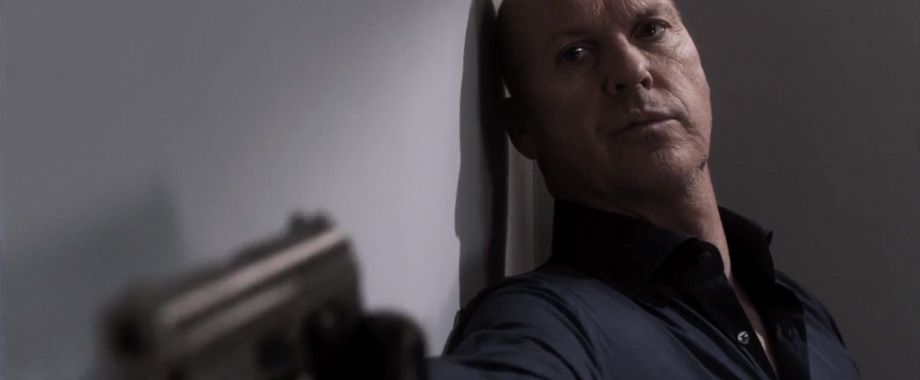
Video
The presentation uses the AVC codec, and is in an aspect ratio of 1.85:1. Shot digitally (using the Arri Alexa) in Ottawa, the film was obviously a fairly cheap production and was mostly recorded on a studio set: during the scenes set on the terrace, there is some obvious compositing used to create the illusion that the characters are outside rather than within a studio. There is some brief location work, during Sara’s trip outside the apartment. Nevertheless, despite the studio-bound nature of the production, there is some excellent photography by Chris Seager, a veteran of British television who has worked on programmes as diverse as Call the Midwife (BBC, 2012- ) and Game of Thrones (HBO, 2011- ). Seager allows some of the scenes depicting Chad’s stalking of Sara in her penthouse apartment to play out in silhouette, and during the second half of the movie there is some very good low-light photography as a fuse is blown and the lights in Sara’s apartment go out. Contrast, colour reproduction and black levels are good on this transfer, and these low-light sequences, often a problem on the DVD format, work very nicely in this HD presentation.
Audio
Audio is presented via a Dolby Digital 5.1 track and a Dolby Digital 2.0 stereo mix. Both are very strong, with the 5.1 track being slightly more immersive (although it’s not ‘showy’, by any means) and showcasing Mark Mancina’s impressive orchestral score. A lossless audio option would have been preferable but, arguably, is not absolutely essential.
Extras
There are no extras other than a group of bonus trailers which play on disc startup, for Scavengers, Bloody Homecoming and The Black Water Vampire (4:16).
Overall
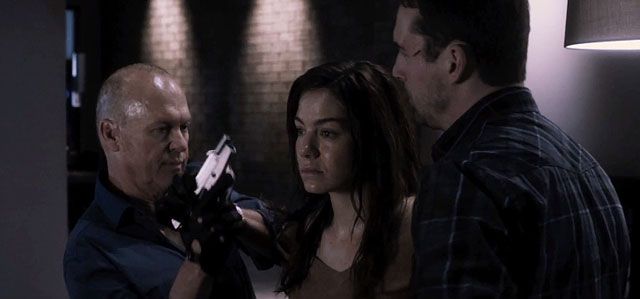 Penthouse North is a modest triumph: the film is largely a throwback to a more simple era of thrillers, with a fairly familiar narrative that is fleshed out with some interesting thematic content, very good cinematography and strong performances from both Monaghan and Keaton. The opening sequence, set in Afghanistan, is a little unconvincing: Monaghan doesn’t impress as the seasoned Tim Hetherington (or perhaps, Lee Miller)-type war photojournalist that her character seems to be written as. She makes mistakes, shows no connection with the soldiers with whom she is embedded, gets in the line of fire, and has to be shepherded to safety. (Additionally, although it’s a trivial detail, she seems to be using an entry level, crop-sensor Nikon DSLR with the kit lens; photographers in such contexts are more likely to use a full-frame DSLR, although some – for example, the New York Times’ Damon Winter – have over the past few years begun to use iPhones for the kinds of candid shots of troops that Monaghan is supposed to be taking here.) However, after the opening titles have ended and the film relocates to New York City, Ruben seems much more confident in his material. In fact, this is the kind of film that, at one point, would have enjoyed a cinema release but now is relegated to the ‘straight to video’ ghetto – which is a crying shame. Sadly, there is no contextual material with this release, but the film itself is a fine, lowkey thriller that provides an effective antidote to the action-laden thrillers that grace cinema screens nowadays. The studiobound nature of the film is all too obvious but, given the quality of the performances and photography, not too detrimental; the HD presentation is very good, although a lossless audio track would have been preferable. Penthouse North is a modest triumph: the film is largely a throwback to a more simple era of thrillers, with a fairly familiar narrative that is fleshed out with some interesting thematic content, very good cinematography and strong performances from both Monaghan and Keaton. The opening sequence, set in Afghanistan, is a little unconvincing: Monaghan doesn’t impress as the seasoned Tim Hetherington (or perhaps, Lee Miller)-type war photojournalist that her character seems to be written as. She makes mistakes, shows no connection with the soldiers with whom she is embedded, gets in the line of fire, and has to be shepherded to safety. (Additionally, although it’s a trivial detail, she seems to be using an entry level, crop-sensor Nikon DSLR with the kit lens; photographers in such contexts are more likely to use a full-frame DSLR, although some – for example, the New York Times’ Damon Winter – have over the past few years begun to use iPhones for the kinds of candid shots of troops that Monaghan is supposed to be taking here.) However, after the opening titles have ended and the film relocates to New York City, Ruben seems much more confident in his material. In fact, this is the kind of film that, at one point, would have enjoyed a cinema release but now is relegated to the ‘straight to video’ ghetto – which is a crying shame. Sadly, there is no contextual material with this release, but the film itself is a fine, lowkey thriller that provides an effective antidote to the action-laden thrillers that grace cinema screens nowadays. The studiobound nature of the film is all too obvious but, given the quality of the performances and photography, not too detrimental; the HD presentation is very good, although a lossless audio track would have been preferable.
|
|||||

|